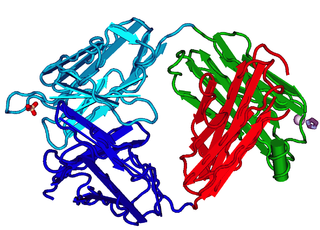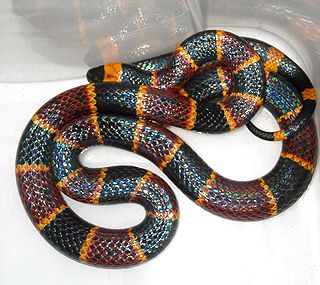Related Research Articles

An antibody (Ab), also known as an immunoglobulin (Ig), is a large, Y-shaped protein used by the immune system to identify and neutralize foreign objects such as pathogenic bacteria and viruses. The antibody recognizes a unique molecule of the pathogen, called an antigen. Each tip of the "Y" of an antibody contains a paratope that is specific for one particular epitope on an antigen, allowing these two structures to bind together with precision. Using this binding mechanism, an antibody can tag a microbe or an infected cell for attack by other parts of the immune system, or can neutralize it directly.

Atracidae is a family of mygalomorph spiders, commonly known as Australian funnel-web spiders or atracids. It has been included as a subfamily of the Hexathelidae, but is now recognized as a separate family. All members of the family are native to Australia. Atracidae consists of three genera: Atrax, Hadronyche, and Illawarra, comprising 35 species. Some members of the family produce venom that is dangerous to humans, and bites by spiders of six of the species have caused severe injuries to victims. The bites of the Sydney funnel-web spider and northern tree-dwelling funnel-web spider are potentially deadly, but no fatalities have occurred since the introduction of modern first-aid techniques and antivenom.

Antivenom, also known as antivenin, venom antiserum, and antivenom immunoglobulin, is a specific treatment for envenomation. It is composed of antibodies and used to treat certain venomous bites and stings. Antivenoms are recommended only if there is significant toxicity or a high risk of toxicity. The specific antivenom needed depends on the species involved. It is given by injection.

A snakebite is an injury caused by the bite of a snake, especially a venomous snake. A common sign of a bite from a venomous snake is the presence of two puncture wounds from the animal's fangs. Sometimes venom injection from the bite may occur. This may result in redness, swelling, and severe pain at the area, which may take up to an hour to appear. Vomiting, blurred vision, tingling of the limbs, and sweating may result. Most bites are on the hands, arms, or legs. Fear following a bite is common with symptoms of a racing heart and feeling faint. The venom may cause bleeding, kidney failure, a severe allergic reaction, tissue death around the bite, or breathing problems. Bites may result in the loss of a limb or other chronic problems or even death.
Antiserum is a blood serum containing monoclonal or polyclonal antibodies that is used to spread passive immunity to many diseases via blood donation (plasmapheresis). For example, convalescent serum, passive antibody transfusion from a previous human survivor, used to be the only known effective treatment for ebola infection with a high success rate of 7 out of 8 patients surviving.

Envenomation is the process by which venom is injected by the bite or sting of a venomous animal.

Crotalus scutulatus is a highly venomous pit viper species found in the deserts of the southwestern United States and central Mexico. It is perhaps best known for its potent neurotoxic-hemotoxic venom, which is considered the world's most potent rattlesnake venom.
Crotalidae Polyvalent Immune Fab (ovine), sold under the brandname CroFab, is a snake antivenin, indicated for North American Crotalid (Rattlesnake, Copperhead and Cottonmouth/Water moccasin) snake envenomation.

A spider bite, also known as arachnidism, is an injury resulting from the bite of a spider. The effects of most bites are not serious. Most bites result in mild symptoms around the area of the bite. Rarely they may produce a necrotic skin wound or severe pain.

Naja is a genus of venomous elapid snakes commonly known as cobras. Members of the genus Naja are the most widespread and the most widely recognized as "true" cobras. Various species occur in regions throughout Africa, Southwest Asia, South Asia, and Southeast Asia. Several other elapid species are also called "cobras", such as the king cobra and the rinkhals, but neither is a true cobra, in that they do not belong to the genus Naja, but instead each belong to monotypic genera Hemachatus and Ophiophagus.

Micrurus tener, commonly known as the Texas coral snake, is a species of venomous snake in the family Elapidae. The species is native to the southern United States and adjacent northeastern and central Mexico. Five subspecies are recognized as being valid, including the nominotypical subspecies, Micrurus tener tener, which is found in both the US and Mexico, and is also commonly known as the Texas coral snake. The species Micrurus tener was once considered to be a subspecies of the eastern coral snake.

Delta atracotoxin is a low-molecular-weight neurotoxic polypeptide found in the venom of the Sydney funnel-web spider.

Latrodectism is the illness caused by the bite of Latrodectus spiders. Pain, muscle rigidity, vomiting, and sweating are the symptoms of latrodectism.

Venomous fish are species of fish which produce strong mixtures of toxins harmful to humans which they deliberately deliver by means of a bite, sting, or stab, resulting in an envenomation. As a contrast, poisonous fish also produce a strong toxin, but they do not bite, sting, or stab to deliver the toxin, instead being poisonous to eat because the human digestive system does not destroy the toxin they contain in their bodies. Venomous fish do not necessarily cause poisoning if they are eaten, as the digestive system often destroys the venom.

The fragment antigen-binding region is a region on an antibody that binds to antigens. It is composed of one constant and one variable domain of each of the heavy and the light chain. The variable domain contains the paratope, comprising a set of complementarity-determining regions, at the amino terminal end of the monomer. Each arm of the Y thus binds an epitope on the antigen.

Micrurus fulvius, commonly known as the eastern coral snake, common coral snake, American cobra, and more, is a species of highly venomous coral snake in the family Elapidae. The species is endemic to the southeastern United States. It should not be confused with the scarlet snake or scarlet kingsnake, which are harmless mimics. No subspecies are currently recognized.
The Instituto Bioclon S.A. de C.V. was formed in 1990 to research and develop F(ab’)2 antivenoms. On May 6, 2015 they received approval from the FDA to commercialize ANAVIP becoming their second drug approved by the FDA after ANASCORP. Both are commercialized in the US by Rare Disease Therapeutics, Inc. The company is performing clinical trials to get approval for a third drug, ANALATRO, designed to treat black widow spider envenomation.
Recombinant antibodies are antibody fragments produced by using recombinant antibody coding genes. They mostly consist of a heavy and light chain of the variable region of immunoglobulin. Recombinant antibodies have many advantages in both medical and research applications, which make them a popular subject of exploration and new production against specific targets. The most commonly used form is the single chain variable fragment (scFv), which has shown the most promising traits exploitable in human medicine and research. In contrast to monoclonal antibodies produced by hybridoma technology, which may lose the capacity to produce the desired antibody over time or the antibody may undergo unwanted changes, which affect its functionality, recombinant antibodies produced in phage display maintain high standard of specificity and low immunogenicity.
ANAVIP is the trade name of a snake antivenin indicated for the management of adult and pediatric patients with North American rattlesnake envenomation. As defined by the FDA, the proper name is crotalidae immune F(ab')2 (equine). It is manufactured by Instituto Bioclon for Rare Disease Therapeutics in the United States.
References
- ↑ Stuart MC, Kouimtzi M, Hill SR, eds. (2009). WHO Model Formulary 2008. World Health Organization. p. X. hdl: 10665/44053 . ISBN 9789241547659.
- ↑ de la Rosa G, Olvera F, Archundia IG, Lomonte B, Alagón A, Corzo G (August 2019). "Horse immunization with short-chain consensus α-neurotoxin generates antibodies against broad spectrum of elapid venomous species". Nature Communications. 10 (1): 3642. Bibcode:2019NatCo..10.3642D. doi:10.1038/s41467-019-11639-2. PMC 6692343 . PMID 31409779.
- ↑ World Health Organization model list of essential medicines (21st list 2019 ed.). Geneva: World Health Organization. 2019. hdl: 10665/325771 . WHO/MVP/EMP/IAU/2019.06. License: CC BY-NC-SA 3.0 IGO.
- ↑ WHO Expert Committee on Biological Standardization (2017). "Annex 5; Guidelines for the production, control and regulation of snake antivenom immunoglobulins;Replacement of Annex 2 of WHO Technical Report Series, No. 964" (PDF). WHO Expert Committee on Biological Standardization, sixty-seventh report. Geneva, Switzerland: World Health Organization (WHO). pp. 197–388. hdl: 10665/255657 . ISBN 978-92-4-069645-7. ISSN 0512-3054. WHO technical report series;1004. License: CC BY-NC-SA 3.0 IGO. Archived (PDF) from the original on 2020-02-14. Retrieved 2020-01-20.
- ↑ Sánchez EE, Galán JA, Perez JC, Rodríguez-Acosta A, Chase PB, Pérez JC (March 2003). "The efficacy of two antivenoms against the venom of North American snakes". Toxicon. 41 (3): 357–65. doi:10.1016/s0041-0101(02)00330-6. PMID 12565759.
- ↑ Lewis, Danny (11 September 2015). "Why A Single Vial Of Antivenom Can Cost $14,000". Smithsonian. Archived from the original on 3 May 2019. Retrieved 9 January 2017.
- ↑ "Antivenom Supply for Snake bites". www.pharmaceutical-technology.com. 24 April 2019. Archived from the original on 10 January 2021. Retrieved 25 July 2020.
- ↑ "Safety & Availability (Biologics) > Expiration Date Extension for North American Coral Snake Antivenin (Micrurus fulvius) (Equine Origin) Lot 4030026 Through October 31, 2014". Food and Drug Administration. Archived from the original on 3 March 2016. Retrieved 19 March 2016.
- 1 2 Breen, David (12 October 2013). "Risk from coral-snake bites grows as antivenin dwindles". Orlando Sentinel. Archived from the original on 24 May 2014. Retrieved 25 May 2014.
- ↑ "Antivenom Shortages – Cost of Antivenom Production Creates Shortages". Popular Mechanics. 2010-05-10. Archived from the original on 2010-05-13. Retrieved 2010-11-16.
- ↑ "Our Products – Coralmyn". Bioclon.com.mx. Archived from the original on 13 October 2010. Retrieved 2010-11-16.
- ↑ "Coral Snake Antivenom - Poison Center Tampa". Poison Center Tampa. Archived from the original on 1 April 2016. Retrieved 19 March 2016.
- ↑ "Emergency Treatment of Coral Snake Envenomation With Antivenom - Full Text View - ClinicalTrials.gov". National Institutes of Health. Archived from the original on 30 March 2016. Retrieved 19 March 2016.
- ↑ Spawls S, Branch B (1995). The Dangerous Snakes of Africa. Ralph Curtis Books. Dubai: Oriental Press. p. 192. ISBN 0-88359-029-8.